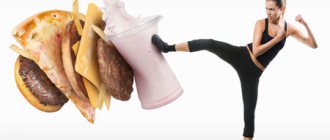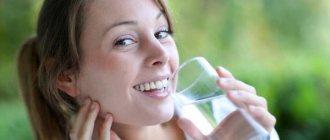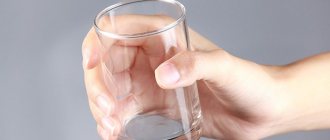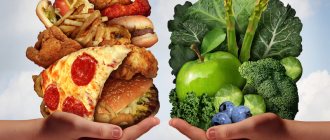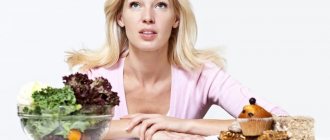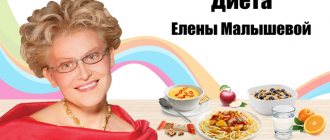General rules
The effectiveness of instrumental methods for examining various parts of the large intestine, in particular colonoscopy , and the timely diagnosis of pathology during their implementation are largely due to the quality of intestinal cleansing.
Despite the obviousness and understanding by patients of the importance of adequate preliminary bowel preparation, in practice, endoscopists quite often encounter poor visualization during colonoscopy, which is the reason for missing a pathological focus or neoplasms, as well as insufficiently accurate determination of the boundaries of its localization. A mandatory step in preparing the intestines and abdominal organs for examination ( colonoscopy , before MRI of the abdominal cavity, before ultrasound), as well as before intestinal surgery, is a slag-free diet. If the diet is not followed or carried out incorrectly, all efforts to prepare the intestines, even when taking the most effective oral medications, will not give the desired result.
What is a slag-free diet? This is a short-term therapeutic nutrition in which the diet includes foods and foods that create a minimum amount of solid excrement and promote the removal of feces from the body and maximum cleansing of the intestines from toxins.
When preparing for a colonoscopy, the main task is to maximally clean the intestinal lumen and mucous membrane from dense undigested food residues and mucus. At the same time, a waste-free diet before a colonoscopy not only cleanses the intestines, but also restores physiologically normal peristalsis, improves metabolism and overall well-being, since dietary nutrition also cleanses the body of waste and toxins . The diet, in most cases, is prescribed 3 days before the colonoscopy procedure, however, if there are a number of indications (anomalies of intestinal development, regular constipation ), the period can vary from 3 to 7 days.
Basic principles of the diet:
- The diet is unbalanced and physiologically inferior, so it can only be prescribed for a short period of time.
- The diet before intestinal colonoscopy should maximally maintain water balance and provide the body with vitamins , microelements and a small amount of energy.
- The food menu completely excludes indigestible foods that contain a lot of fiber or promote the development of fermentation processes in the intestines: stringy and fatty meats, sausages, fats, canned food, marinades, smoked foods, fresh vegetables, herbs and mushrooms. No legumes, coarse cereals, bran and rye bread, nuts, seeds, whole milk and dairy products, alcohol, and rye flour products are allowed.
- The diet is based on broths, lean dietary meat in small quantities, liquid soups, and cereals.
- Drinking regimen - 1.5-2.0 liters of free liquid per day.
- Products are steamed or boiled. It is forbidden to consume all fried foods, especially those with a crust.
- Excessively salty and spicy dishes and foods are excluded.
- Fractional meals in small portions.
- The day before the examination, you should switch completely to liquid nutrition: vegetable soups, tea with honey, juice diluted with water, low-fat yogurt/kefir.
Slag-free diet - how to prepare for a colonoscopy
Many products of plant origin contain indigestible ballast substances. These dietary fibers are fiber that is needed for the proper functioning of the intestinal tract. But when preparing for a colonoscopy, another goal is pursued - not to normalize the functioning of the digestive system, but to cleanse the intestines of feces. Therefore, the diet before the study should be without fiber, which forms the consistency of stool. This type of nutrition is called slag-free.
Proper preparation for a colonoscopy using a slag-free diet
What is a slag-free diet? What should your diet be like and what exactly can you eat when preparing your bowels?
for a colonoscopy?
A slag-free diet is a diet that does not contain fiber and other foods that cause flatulence and abdominal discomfort. The menu strictly excludes any irritants (both mechanical and chemical) to the mucous membrane of all digestive organs. In a slag-free diet, there is no place for foods and dishes that enhance the processes of rotting and fermentation in the intestines. This diet is prescribed 3-5 days before the colonoscopy to completely cleanse the intestines of feces. If the patient is prone to constipation, then a slag-free diet is prescribed a week before the test.
What should you not eat when preparing for a colonoscopy?
- Fresh vegetables - carrots, beets, radishes, turnips, onions, garlic, white cabbage, broccoli, tomatoes.
- Pasta and legumes - peas, beans, lentils, beans.
- Fruits and berries – oranges, gooseberries, peaches, apricots, grapefruit, tangerines, grapes, currants, kiwi.
- Porridges cooked with milk, and some types of porridges (lentil, pearl barley, millet, corn, oatmeal) are completely excluded, even if they are cooked in water.
- Products made from unrefined cereals - corn flakes, popcorn, bran, muesli.
- Brown bread, whole grain bread.
- Rich meat and fish broths, borscht and pickles.
- Fatty poultry, meat (pork, lamb), fatty fish
- Greens – (lettuce, parsley, cilantro, etc.)
- Mushrooms in any form, green peas
- Nuts (especially almonds and peanuts), dried fruits, dates, raisins, seeds.
- Confectionery and baked goods.
- Any herbs, sauces and spices.
Excluded from liquids:
- Alcohol.
- Carbonated drinks.
- Milk.
- Kvass
For 2-3 days, you should avoid not only foods that provoke fermentation, but also fatty foods. Cooking such as frying is strictly prohibited.
What can you eat in preparation for a colonoscopy?
3-4 days before the colonoscopy (for constipation 7 days before), the following dishes may be included in the menu:
- boiled or steamed poultry (white meat), lean fish, lean beef, rabbit (preferably pureed or in the form of soufflé, meatballs, cutlets);
- soups (borscht or cabbage soup are excluded) in low-fat meat or fish broth;
- freshly prepared cottage cheese,
- semolina and rice porridge (in water), buckwheat porridge without milk,
- day-old white bread;
- 1 egg per day in different forms, except scrambled eggs (soft-boiled, in a “bag” or in the form of a steam omelet);
- Kissels (thin consistency), weak tea (can be green), rosehip decoction,
It is worth giving preference to such culinary processing as steaming, boiling, stewing. Portions should be small and the diet should be fractional.
Preparing for a colonoscopy - sample menu 2 days before the examination.
First breakfast
- Steamed fish cutlets (from lean fish)
- Semolina porridge on water
- Rose hip decoction
Lunch
- Freshly prepared cottage cheese casserole
Dinner
- Meatball soup
- Meatloaf without side dish
- Weak tea
Afternoon snack
- Unsweetened biscuit with weak green tea
Dinner.
- Steam omelette
Diet before colonoscopy
The day before a colonoscopy, doctors recommend easy-to-digest foods, such as clear vegetable broth. From midday onwards, patients are usually not allowed to eat anything else. However, taking liquids (weak tea or just still water) is allowed and desirable. On the day of the examination before the colonoscopy, a person cannot eat anything, so even breakfast is canceled.
Remember, for persistent chronic constipation, a slag-free diet is prescribed for 10 days (at least a week)!
In order for preparation for a colonoscopy to be as effective as possible, the diet must be combined with laxatives.
Authorized Products
The diet menu allows lean broths and clear soups based on vegetables, chicken and beef meat, chicken meat, rabbit, turkey, lean fish, steamed (cod, pike perch, perch, pike), semolina and corn grits, eggs in the form of an omelet or soft-boiled, cheese, olive, sunflower and butter, white rice, premium wheat pasta, boiled and canned vegetables without peels and seeds (cucumbers, potatoes, carrots, mushrooms), fruit juice without pulp, ripe melon, peaches , apricots, purified non-carbonated drinking water, black and green tea, coffee without cream and milk, jelly, compotes without grounds, natural syrups and jellies, honey, dairy products (low-fat cottage cheese, yogurt without additives, kefir, skim milk), powdered without yeast dietary cookies (without fruit additives), crackers, white bread crackers.
Table of permitted products
| Proteins, g | Fats, g | Carbohydrates, g | Calories, kcal | |
Vegetables and greens | ||||
| canned eggplants | 0,9 | 0,7 | 7,3 | 49 |
| mashed potatoes | 2,5 | 4,2 | 14,7 | 106 |
| boiled carrots | 0,8 | 0,3 | 5,0 | 25 |
| canned cucumbers | 2,8 | 0,0 | 1,3 | 16 |
| boiled beets | 1,8 | 0,0 | 10,8 | 49 |
| canned tomatoes | 1,1 | 0,1 | 3,5 | 20 |
Fruits | ||||
| canned fruits | 0,5 | 0,1 | 9,5 | 40 |
| apricots | 0,9 | 0,1 | 10,8 | 41 |
| peaches | 0,9 | 0,1 | 11,3 | 46 |
Cereals and porridges | ||||
| buckwheat | 4,5 | 2,3 | 25,0 | 132 |
| semolina porridge on water | 2,5 | 0,2 | 16,8 | 80 |
| white boiled rice | 2,2 | 0,5 | 24,9 | 116 |
Flour and pasta | ||||
| premium boiled pasta | 3,5 | 0,4 | 23,2 | 112 |
| noodles | 12,0 | 3,7 | 60,1 | 322 |
| spaghetti | 10,4 | 1,1 | 71,5 | 344 |
Bakery products | ||||
| white bread crackers | 11,2 | 1,4 | 72,2 | 331 |
Confectionery | ||||
| jelly | 2,7 | 0,0 | 17,9 | 79 |
| cracker cookies | 11,3 | 13,4 | 67,1 | 352 |
Raw materials and seasonings | ||||
| honey | 0,8 | 0,0 | 81,5 | 329 |
| sugar | 0,0 | 0,0 | 99,7 | 398 |
Dairy | ||||
| dairy products | 3,2 | 6,5 | 4,1 | 117 |
Cheeses and cottage cheese | ||||
| cheese | 24,1 | 29,5 | 0,3 | 363 |
| cottage cheese 0.6% (low fat) | 18,0 | 0,6 | 1,8 | 88 |
Meat products | ||||
| boiled beef | 25,8 | 16,8 | 0,0 | 254 |
| veal | 19,7 | 1,2 | 0,0 | 90 |
Sausages | ||||
| boiled diet sausage | 12,1 | 13,5 | 0,0 | 170 |
Bird | ||||
| boiled chicken breast | 29,8 | 1,8 | 0,5 | 137 |
| boiled turkey fillet | 25,0 | 1,0 | — | 130 |
Eggs | ||||
| omelette | 9,6 | 15,4 | 1,9 | 184 |
| soft-boiled chicken eggs | 12,8 | 11,6 | 0,8 | 159 |
Fish and seafood | ||||
| boiled fish | 17,3 | 5,0 | 0,0 | 116 |
| zander | 19,2 | 0,7 | — | 84 |
| cod | 17,7 | 0,7 | — | 78 |
| pike | 18,4 | 0,8 | — | 82 |
Oils and fats | ||||
| vegetable oil | 0,0 | 99,0 | 0,0 | 899 |
| butter | 0,5 | 82,5 | 0,8 | 748 |
Non-alcoholic drinks | ||||
| green tea | 0,0 | 0,0 | 0,0 | — |
| black tea | 20,0 | 5,1 | 6,9 | 152 |
| hibiscus tea | 0,3 | 0,0 | 0,6 | 5 |
Juices and compotes | ||||
| apricot juice | 0,9 | 0,1 | 9,0 | 38 |
| jelly | 0,2 | 0,0 | 16,7 | 68 |
| Apple juice | 0,4 | 0,4 | 9,8 | 42 |
| * data is per 100 g of product | ||||
Slag-free diet menu for 3 days
The easiest way to start is with a three-day diet. In the future, if it’s easy enough to stick with it for three days, you can switch to a seven-day course - the menu won’t change much. The entire diet is based on clearly defined meal times. For people who are not yet fully accustomed to diets, we provide a sample menu. You can diversify the menu with products from the table above.
First day.
- Breakfast: oatmeal on water with pieces of fruit.
- Second breakfast: beet salad with sour cream.
- Lunch: Lenten cabbage soup with sour cream.
- Afternoon snack: carrot salad with sunflower oil.
- Dinner: steamed chicken cutlets with a light vegetable salad.
Second day.
- Breakfast: buckwheat porridge with fresh berries.
- Second breakfast: cabbage salad.
- Lunch: soup with vegetables (potatoes, cabbage, carrots are allowed).
- Afternoon snack: fresh fruit.
- Dinner: rabbit meatballs and buckwheat porridge.
The third day.
- Breakfast: oatmeal with fresh berries.
- Second breakfast: low-fat yogurt.
- Lunch: stewed vegetables.
- Afternoon snack: lentils with herbs.
- Dinner: boiled chicken breasts and salad on the side.
Just before bed, after six in the evening, you can drink a glass of kefir, herbal or fruit tea. But be sure to avoid sugar, as sugar can cause fermentation, which will negatively affect the results.
Another menu option shown below is also possible.
Fully or partially limited products
Fatty meats, smoked sausages, animal fats, marinades, canned food, smoked foods, any raw vegetables and root vegetables (cabbage, carrots, radishes, beets, turnips, onions, garlic) are completely excluded from the diet; fatty fish, greens (spinach, sorrel); coarse porridge (barley, oatmeal, millet); mushrooms, legumes (lentils, peas, beans, beans), as they cause increased gas formation in the intestines; rye bread and products made from rye flour; fruits (pear, bananas, tangerines, peach, apple, grapes); all types of nuts and dried fruits; any berries; whole milk and dairy products (except fermented milk).
It is not allowed to include chocolate, cocoa, any pastries and sweets, confectionery (cakes, cookies, candies, pastries), carbonated drinks, juices with pulp and nectars in packages, and seasonings in the diet. Drinking any drinks containing alcohol is prohibited.
Table of prohibited products
| Proteins, g | Fats, g | Carbohydrates, g | Calories, kcal | |
Vegetables and greens | ||||
| beans | 6,0 | 0,1 | 8,5 | 57 |
| peas | 6,0 | 0,0 | 9,0 | 60 |
| broccoli | 3,0 | 0,4 | 5,2 | 28 |
| Brussels sprouts | 4,8 | 0,0 | 8,0 | 43 |
| cauliflower | 2,5 | 0,3 | 5,4 | 30 |
| bulb onions | 1,4 | 0,0 | 10,4 | 41 |
| carrot | 1,3 | 0,1 | 6,9 | 32 |
| radish | 1,2 | 0,1 | 3,4 | 19 |
| white radish | 1,4 | 0,0 | 4,1 | 21 |
| turnip | 1,5 | 0,1 | 6,2 | 30 |
| beans | 7,8 | 0,5 | 21,5 | 123 |
| horseradish | 3,2 | 0,4 | 10,5 | 56 |
| garlic | 6,5 | 0,5 | 29,9 | 143 |
Fruits | ||||
| oranges | 0,9 | 0,2 | 8,1 | 36 |
| bananas | 1,5 | 0,2 | 21,8 | 95 |
| cherry | 0,8 | 0,5 | 11,3 | 52 |
| grapefruit | 0,7 | 0,2 | 6,5 | 29 |
| lemons | 0,9 | 0,1 | 3,0 | 16 |
| apples | 0,4 | 0,4 | 9,8 | 47 |
Berries | ||||
| grape | 0,6 | 0,2 | 16,8 | 65 |
| currant | 1,0 | 0,4 | 7,5 | 43 |
Mushrooms | ||||
| mushrooms | 3,5 | 2,0 | 2,5 | 30 |
Nuts and dried fruits | ||||
| nuts | 15,0 | 40,0 | 20,0 | 500 |
| dried fruits | 2,3 | 0,6 | 68,2 | 286 |
| raisin | 2,9 | 0,6 | 66,0 | 264 |
Snacks | ||||
| potato chips | 5,5 | 30,0 | 53,0 | 520 |
| salted popcorn | 7,3 | 13,5 | 62,7 | 407 |
Cereals and porridges | ||||
| porridge with milk | 3,3 | 2,9 | 17,4 | 105 |
| oat bran | 8,0 | 4,0 | 10,0 | 110 |
| pearl barley porridge | 3,1 | 0,4 | 22,2 | 109 |
| millet porridge | 4,7 | 1,1 | 26,1 | 135 |
| boiled brown rice | 2,6 | 0,9 | 22,8 | 110 |
| barley porridge | 11,5 | 2,0 | 65,8 | 310 |
| rye bran | 11,2 | 3,2 | 32,0 | 221 |
Flour and pasta | ||||
| pancakes | 6,1 | 12,3 | 26,0 | 233 |
| vareniki | 7,6 | 2,3 | 18,7 | 155 |
| dumplings | 11,9 | 12,4 | 29,0 | 275 |
Bakery products | ||||
| loaf with wheat bran | 9,2 | 2,8 | 51,4 | 273 |
| buns | 7,9 | 9,4 | 55,5 | 339 |
| rye-wheat bread | 8,1 | 3,4 | 42,2 | 222 |
Confectionery | ||||
| candies | 4,3 | 19,8 | 67,5 | 453 |
| cake | 3,8 | 22,6 | 47,0 | 397 |
| halva | 11,6 | 29,7 | 54,0 | 523 |
Cakes | ||||
| cake | 4,4 | 23,4 | 45,2 | 407 |
Chocolate | ||||
| chocolate | 5,4 | 35,3 | 56,5 | 544 |
Raw materials and seasonings | ||||
| seasonings | 7,0 | 1,9 | 26,0 | 149 |
| mayonnaise | 2,4 | 67,0 | 3,9 | 627 |
Dairy | ||||
| milk | 3,2 | 3,6 | 4,8 | 64 |
| condensed milk | 7,2 | 8,5 | 56,0 | 320 |
Meat products | ||||
| pork | 16,0 | 21,6 | 0,0 | 259 |
| salo | 2,4 | 89,0 | 0,0 | 797 |
Sausages | ||||
| smoked sausage | 28,2 | 27,5 | 0,0 | 360 |
Bird | ||||
| duck | 16,5 | 61,2 | 0,0 | 346 |
| goose | 16,1 | 33,3 | 0,0 | 364 |
Fish and seafood | ||||
| pink salmon | 20,5 | 6,5 | 0,0 | 142 |
| Red caviar | 32,0 | 15,0 | 0,0 | 263 |
| salmon | 19,8 | 6,3 | 0,0 | 142 |
| seaweed | 0,8 | 5,1 | 0,0 | 49 |
| fish balyk | 20,4 | 12,5 | 0,0 | 194 |
| herring | 16,3 | 10,7 | — | 161 |
| salmon | 21,6 | 6,0 | — | 140 |
Oils and fats | ||||
| animal fat | 0,0 | 99,7 | 0,0 | 897 |
| cooking fat | 0,0 | 99,7 | 0,0 | 897 |
Alcoholic drinks | ||||
| dry white wine | 0,1 | 0,0 | 0,6 | 66 |
| red dessert wine | 0,5 | 0,0 | 20,0 | 172 |
| whiskey | 0,0 | 0,0 | 0,4 | 235 |
| vodka | 0,0 | 0,0 | 0,1 | 235 |
| cognac | 0,0 | 0,0 | 0,1 | 239 |
| liquor | 0,3 | 1,1 | 17,2 | 242 |
| beer | 0,3 | 0,0 | 4,6 | 42 |
Non-alcoholic drinks | ||||
| cola | 0,0 | 0,0 | 10,4 | 42 |
| sprite | 0,1 | 0,0 | 7,0 | 29 |
| tonic | 0,0 | 0,0 | 8,3 | 34 |
| Fanta | 0,0 | 0,0 | 11,7 | 48 |
| energy drink | 0,0 | 0,0 | 11,3 | 45 |
Juices and compotes | ||||
| grape juice | 0,3 | 0,0 | 14,0 | 54 |
| * data is per 100 g of product | ||||
Slag-free diet menu before intestinal colonoscopy (Diet)
The menu before intestinal colonoscopy includes any permitted products and depends on the duration of the diet. Meals are fractional, in small portions.
Sample menu of a slag-free diet for a week:
7-4 days before colonoscopy
| Breakfast |
|
| Snack |
|
| Dinner |
|
| Dinner |
|
3-2 days before colonoscopy
| Breakfast |
|
| Snack |
|
| Dinner |
|
| Dinner |
|
1 day before colonoscopy
| Breakfast |
|
| Snack |
|
| Dinner |
|
| Dinner |
|
Diet after colonoscopy
After colonoscopy, you need to follow a slag-free diet for 3-4 days. Therapeutic nutrition is necessary for the rapid healing of microcracks formed in the intestinal mucosa during the introduction of endoscopic equipment and the normalization of digestion. Food should contain a large amount of plant fiber and be easily digestible. Due to the irritating effect, hot dishes are not allowed - only at room temperature. Small meals enriched with vitamins and minerals.
Can be eaten:
- light vegetable soups with clear broth;
- boiled eggs;
- steamed lean fish;
- boiled dietary meat (veal, turkey or chicken);
- fresh and boiled (stewed) vegetables;
- low-fat fermented milk products (cottage cheese, yogurt, kefir);
- fruits.
Avoid foods that cause bloating (lentils, cabbage, radishes). Whole grain cereals and durum pasta are also not allowed. Bread, cookies and muesli are not allowed.
As a result of colonoscopy, the balance of normal intestinal microorganisms is disrupted. This is due to the mechanical effect on the intestinal wall and the administration of drugs. To restore beneficial bacteria, you need to consume fermented milk products for a week and take probiotics (preferably in soluble forms, not tablets).
In the first days after the procedure, you should not use laxatives, iron supplements, antiplatelet agents (Aspirin, Warfarin, etc.), or perform cleansing enemas. Due to irritation and disruption of the integrity of the mucous membrane, intestinal bleeding can be provoked.
The doctor should determine the patient’s diet before and after colonoscopy depending on his state of health and existing diseases of the digestive tract.
Quitting the diet
After successful completion of the procedure, exit from the slag-free diet should be carried out gradually over 5-7 days. If the rules for leaving the diet are not followed and fatty meat products and root vegetables are quickly included in the diet, there is a danger of constipation and fecal stones.
Therefore, expand your diet after the examination gradually, filling it first with foods that are easily digested in the intestines (cereals, vegetables, fruits), and then, if you feel normal, introduce fatty meats and other previously prohibited foods. Don't forget to drink plenty of fluids. probiotics after a colonoscopy to normalize the microflora of the gastrointestinal tract , which will also help improve digestion.
Comments from nutritionists
The diet in preparation for an intestinal examination can be called strict and unbalanced, since it excludes the consumption of sufficient quantities of various foods that provide the body with the necessary amount of energy, proteins, fats, and carbohydrates.
In this regard, many patients in the first days may feel dizzy , general malaise, and experience acute attacks of hunger. To make life as easy as possible during this period, do not allow heavy physical activity and avoid stressful situations. Try to reduce the intensity of work during this period and interrupt sports activities. Do not schedule a colonoscopy during periods of intense brain activity (sessions, presentations at work) that require careful preparation.
Many believe that this “low-slag” diet can be used for other purposes, in particular to cleanse the body of waste and toxins . This is a misconception. This food is intended directly to prepare the intestines for the examination. And the “slagging” of the body must be reduced by other types of diets, in particular, by holding regular (2-3 times a week) fasting days (kefir, vegetable, cottage cheese), as well as special types of body cleansing, for example, a Russian/Finnish bath.
What does a “residue-free diet” mean?
From the name it is obvious that this diet is designed to rid the body of toxins and provide comprehensive cleansing. In particular, the stomach and intestines are cleansed: by adhering to a diet, you can remove waste retained in it from the gastrointestinal tract.
Weight loss here is more of an accompanying, “side” effect, but in a week it is quite possible to lose 4-5 kilograms.
The diet instructions are:
- You need to drink a lot of water, even before eating, so that the water in the stomach does not slow down the digestion process.
- You will eat mainly soups, broths and liquid porridges - those that are easily absorbed by the body. Poultry, rabbit and other dietary meat are also allowed, but must be boiled or steamed.
- Food must be heated, but not hot.
- You need to eat little, but often: it is optimal to take portions of 300 grams of food five times a day strictly before 18:00.
- You should not eat foods rich in fiber and fat, as well as alcoholic drinks, which can cause fermentation processes.
- Serious stress, both physical and intellectual, is excluded: due to a lack of fiber and fat, the body will receive less energy than with a normal diet.
To cleanse the body, you need to stick to the diet for no more than three days, but following a seven-day diet will help enhance the effect.
Results and reviews
Since a slag-free diet in preparation for colonoscopy is mandatory, patient reviews differ mainly in tolerability, and its results are directly determined by the creation of conditions for conducting a high-quality examination of the intestines.
- “... When I suspected an intestinal tumor, I was prescribed a colonoscopy and a slag-free diet 5 days before the examination. I ate only what I could eat and didn’t allow myself anything extra. For me these were painful days - a strong and constant feeling of hunger, a headache, I could not do anything. I could hardly stand it, but the doctor said that I was well prepared for the examination”;
- “... A sigmoidoscopy was prescribed. Before the sigmoidoscopy, the doctor advised me to go on a 1-2 day diet with the exclusion of foods that cause increased gas formation in the intestines and to do a high-quality cleansing enema. The examination went well."
